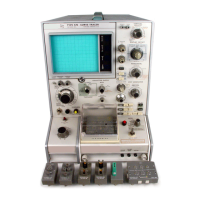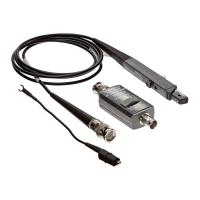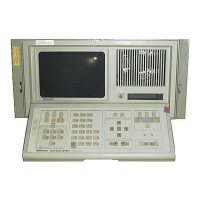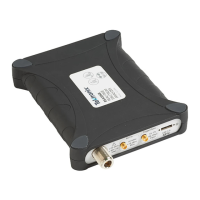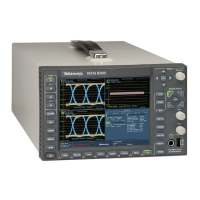Section 4 - Waveform Mode
4-12
VM700A Option 01 (NTSC) & Option 11 (PAL) User Manual
and when the signal frequency is actually too high to measure. The formula used
for calculating the Sine pk-pk (mV), freq (MHz), and offset (mV) values is:
f(t) = A sin(Σt) + B
where A = pk-pk/2, Σ = 2πfreq, and B = offset. The second and third cursors
status lines display values relative to the cursor positions and to the horizontal
reference line.
When cursors are displayed, a cursor can be moved from its default position in
the middle of the display by locking it to a point on the waveform. Use the
control knob to position the waveform under the cursors, then lock one of the
cursors with the Lock Left or Lock Right soft key. You can now move both
cursor and waveform horizontally.
If the Left or Right cursor is moved off the screen and lost from view, it can be
easily brought back on the display by selecting the Center Left or Center Right
soft key, as appropriate. With a cursor locked to the waveform, selecting the
corresponding Center soft key will horizontally center the cursor and the point
on the waveform to which it is locked. This technique may be used to toggle
between any two points in a frame.
Cursors can help you make extremely accurate time measurements over short or
very long intervals. For example, you can measure rise times or the length of up
to two fields of video. To familiarize you with cursors, the following text
explains how to measure the rise time of the leading edge of horizontal sync.
While learning to use cursors, you’ll find it much easier to use the stable output
of a test signal generator than live video. You can also select Freeze to stabilize
the signal.
Note that the VM700A bandwidth limits the signal to 6 MHz. To accurately
display rise times of signals with significant frequency components between 5
MHz and 6 MHz, select Precision mode.
To Use Cursors to Measure a Rise Time. First, use the control knob and the
Vertical/Horizontal buttons to position the leading edge of a sync pulse in the
center of the screen and then expand the sync edge to fill ≈80% of the screen.
Select the Reset Cursors soft key to center the cursors, reset the amplitude
reference markers, and turn off any previously selected cursor Lock soft keys.
Attach the left amplitude reference marker to a stable spot on the blanking level
prior to the leading edge of sync by moving the waveform to the right until the
blanking level reaches the cursor. This establishes the 100% point of sync. Then
attach the right amplitude reference marker to a stable spot on the sync tip by
moving the waveform to the left until the sync tip reaches the cursor. This
establishes the 0% point of sync. Live video may require moving the sync edge a
little further in both directions to find an average or stable level for the 100% and
Moving Cursors-Lock Left,
Lock Right, Center Left,
and Center Right
Using Cursors to Measure
Timing

